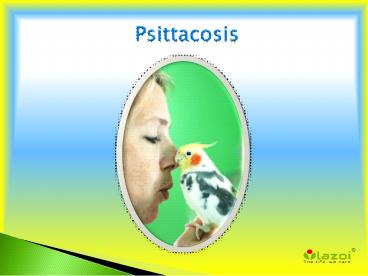Psittacosis: Causes, Symptoms, Daignosis, Prevention and Treatment - PowerPoint PPT Presentation
Title:
Psittacosis: Causes, Symptoms, Daignosis, Prevention and Treatment
Description:
Psittacosis is an infectious disease that contains flu-like symptoms further affecting humans it is caused by a microorganism called Chlamydophila psittaci. – PowerPoint PPT presentation
Number of Views:78
Title: Psittacosis: Causes, Symptoms, Daignosis, Prevention and Treatment
1
Psittacosis
2
Psittacosis
- Psittacosis is an infectious disease that
contains flu-like symptoms further affecting
humans it is caused by a microorganism called
Chlamydophila psittaci.Psittacosis is commonly
contracted from parrots, pigeons and poultry
birds (the bacteria causes avian chlamydiosis in
these birds), but other birds can also transmit
the disease.This condition mainly attacks the
lungs and damages them, leading to the symptoms
of dry cough, fever, chills, fatigue, and
shortness of breath. The infection may also
progress and affect other organs like the brain,
heart, and liver.
3
What are the risk factors associated with
Psittacosis?
- The risk factors of Psittacosis include
- Birds owners, commonly parrot or pigeon owners
- Pet shop employees
- Veterinarians, lab workers
- Those who work in poultry farms, individuals who
slaughter and process poultry - It is important to note that having a risk
factor does not mean that one will get the
condition. A risk factor increases ones
probability of getting a condition compared to an
individual who is not having the risk factors.
Some risk factors are more important than others.
4
What are the causes of Psittacosis?
- Psittacosis is a bacterial infection that is
caused by the pathogenic organism Chlamydia
psittaci. This bacterium generally goes into the
body through inhalation of the infected birds
respiratory droplets and dried feces powder
(droppings).A transmission of the infection can
also occur through bird bites (pecks),
beak-to-mouth contact, and while handling the
birds (from bird plumage). The infected birds
often do not present any signs and
symptoms.Occasionally, the infected birds
spread the disease to mammals (cattle, sheep, and
goats), resulting in the spread of Psittacosis to
humans through direct contact, on exposure to the
mammals. Human to human transmission is also
possible, though it is rarely seen.
5
How is Psittacosis diagnosed?
- The diagnosis of Psittacosis may include
- Complete evaluation of medical history along with
a thorough physical exam. During physical exam,
the physician will listen to abnormal lung sounds - Complete blood count (CBC) The white blood cell
levels may be normal to mildly decreased - Serologic test to observe antibody titre against
the organism - X-ray of the chest It may reveal the presence of
pneumonia - CT scan of the chest
- Blood culture A culture of the organism is
usually avoided, because it can be hazardous to
the laboratory workers
6
How is Psittacosis diagnosed?
Continue
- Many clinical conditions may have similar signs
and symptoms. Your doctor may recommend some
additional tests to extract other clinical
conditions to get at a definitive diagnosis.
7
What are the signs symptoms of Psittacosis?
- Normally, the signs and symptoms of Psittacosis
appear within the first 2 weeks on exposure to
the organism (incubation period of 5-19 days). It
includes the following - Dry cough, sore throat
- Shortness of breath, fatigue
- Chest pain
- Fever and chills
- Headache, joint aches, and muscle aches
- Nausea and vomiting
- Pneumonia
- Abdominal pain
- Jaundice
- Photophobia (increased sensitivity to light)
8
How is Psittacosis treated?
- Psittacosis treatment is undertaken using
antibiotics. Doxycycline is the most commonly
used antibiotic, while other antibiotics that may
be administered include - Macrolides
- Fluoroquinolones
- Intravenous administration of antibiotics in
severe cases
9
CONNECT WITH US
- Logon to
- www.lazoi.com
- Like us on Facebook
- https//www.facebook.com/LazoiTheLife
- Follow us on Twitter
- https//www.twitter.com/lazoithelife
- Follow us on Pinterest
- https//www.in.pinterest.com/lazoithelife































